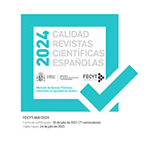Heraldry and entailment identity in pre-modern Portugal
Abstract
Like the nobilities and aristocracies of pre-modern Europe, many Portuguese noble families used heraldry to build, consolidate, transmit, and perpetuate identity traits that, internally and externally, defined a sense of belonging to a group. Among the different solutions adopted to regulate the use and transmission of arms and the rest of the family's symbolic heritage were entails. Entails were legal institutions that framed kinship and organized heritage transmission. They were also creators of identity, here defined as “entailment identity”. The aim of this article is to evaluate the relationship between heraldry and entailment identity from a holistic and contextual perspective. It aims to present the role played by heraldry within the scope of entailment, contextualizing the interpretation of heraldic manifestations within a broader identity logic. The concept of entailment identity is briefly presented in the first section of the article. The second section demonstrates the functioning of the relationship between heraldry and entailment identity based on a case study, the entail founded in 1621 by a secretary of state of king Filipe II, Luís de Figueiredo Falcão.
Downloads
Article download
License
In order to support the global exchange of knowledge, the journal Eikon Imago is allowing unrestricted access to its content as from its publication in this electronic edition, and as such it is an open-access journal. The originals published in this journal are the property of the Complutense University of Madrid and any reproduction thereof in full or in part must cite the source. All content is distributed under a Creative Commons Attribution 4.0 use and distribution licence (CC BY 4.0). This circumstance must be expressly stated in these terms where necessary. You can view the summary and the complete legal text of the licence.











